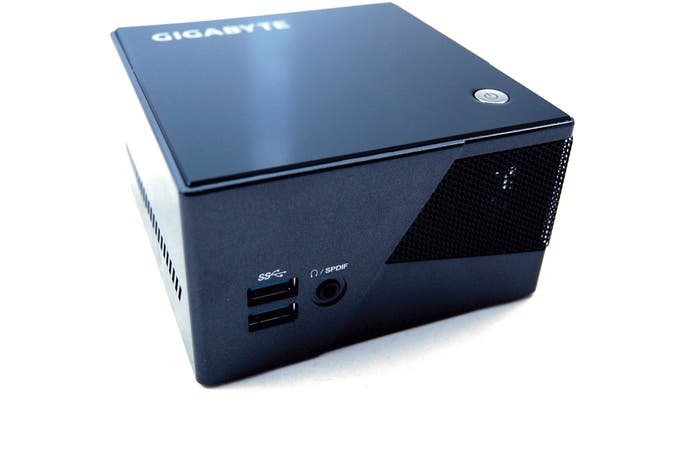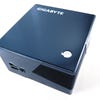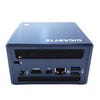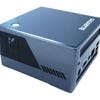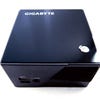Gigabyte Brix Pro GB-BXi7-4770R review
Digital Foundry on the powerful, ultra-mini Steam Machine you can buy now.
The allure of the Gigabyte Brix Pro is undeniable - what we have here is a full desktop Core i7 quad-core CPU integrated into a minuscule case that fits into the palm of your hand. In addition to this one-of-a-kind combination of power and portability, it also features Iris Pro 5200 graphics - the most powerful GPU Intel has ever released, hitherto found in this form only in the latest iMacs. Gigabyte has put forward this device as its debut Steam Machine, and Valve itself gave away one of these units to every game-maker that attended its recent Steam Developer Days event in Seattle. As a unique piece of technology, not to mention its status as a games console of the future, we just had to check it out.
While the SteamOS platform is still in development, the Gigabyte Brix Pro is available to buy right now, and Valve's current beta OS works with the diminutive PC. But let's be clear here - we can't review the unit as a Steam Machine. The hardware might be complete, but SteamOS itself is still a long way off show-time and not in anything like a reviewable state. On top that, we're lacking hands-on time with Valve's intriguing controller. However, the machine is available to buy now and can definitely be assessed in terms of its hardware design and of course its Windows performance. Additionally, it's our contention that the findings there fundamentally define the unit's suitability for gaming, no matter which operating system you have installed.
First impressions on removing the Brix Pro from its svelte packaging are actually quite delightful. Even though you're expecting a small form-factor PC, holding the unit in your hand generates a sensation of pure disbelief - it's absolutely tiny. Never before has a high-end desktop processor been presented in so small a box, and in its Steam Machine guise, this may well be the smallest high-power games console you've ever seen.
It's also exceptionally easy to set up. Assuming you're buying the barebones kit, all you need to provide are the laptop-style SODIMM memory modules, plus storage. The Brix Pro features an mSATA connection, but it also allows for a 2.5-inch drives as well, so there's nothing to stop you running the OS from the former, with mass storage on the latter. Or if you really wanted to push the envelope - and your budget - you could utilise SSDs in both.
Our review unit comes with a Kingston 240GB SSD and 8GB of DDR3, and loading up Windows 8.1 is - to put it simply - brutally fast. Copying across our Origin and Steam libraries via a USB 3.0 hard drive, we couldn't wait to get going.
Now, despite the inclusion of Iris Pro graphics, we need to accept that this is still an integrated GPU at its heart - albeit one with 128MB of eDRAM attached to the processor, designed to mitigate the lack of bandwidth available from the main DDR3 system RAM. With Battlefield 4, we opted for 1600x900 at medium settings with v-sync engaged for a console-style experience. While average frame-rates were reasonable enough, the consistency of the experience felt sub-par compared to the AMD Kaveri tech we recently reviewed. That said, running Battlefield at all on an Intel integrated GPU is quite an achievement.
We tested other titles too and came up with varying results. Crysis 3's initial level played pretty nicely at around the 30fps level at 1600x900 on medium settings with 2x SMAA and v-sync enabled, suggesting a GPU solution well beyond the Intel HD 4600 we previously tested on the i7-4770K with its HD 4600 integrated graphics. However, moving onto the second, more arboreal Welcome to the Jungle stage, frame-rates collapsed and the only way to get a playable experience was to drop down to 720p and low settings. That's exactly what we used to decent effect with the HD 4600, with only anti-aliasing and higher quality textures separating Iris Pro from its far less capable sibling.
"Iris Pro has enough power to run Battlefield 4 at medium settings, but the experience wasn't quite what we hoped for."
To be honest, with Crysis 3 we expected much better from a part that is so much more capable than its stablemate. Iris Pro caches GPU data in its 128MB of eDRAM, but its utilisation is entirely driver-based - and we have no idea of just how well the memory is used on any given game. In fact, we aren't quite sure how Iris Pro caches the data at all, so we're left in the dark as to how the eDRAM is utilised from game to game. Perhaps some games are simply better suited to this non-standard set-up?
Square Enix's Tomb Raider was our next destination and it produced by far the best and most consistent experience out of all the games tested. We played through the title at 1080p on medium settings and 720p on high, both with v-sync enabled, and were rewarded with frame-rates well worth north of 30fps on both - and indeed, much closer to 60fps on the latter. This was the kind of experience we were hoping for from Iris Pro - a convincing mid-point between last-gen and next-gen consoles. Need for Speed: Rivals wasn't so convincing though: 1600x900 at medium settings produced disappointing frame-rates, and the only way we could hit the game's 30fps standard involved dropping resolution down to 720p and pegging all quality settings at the medium level.
It's not quite what we expected. After all, the benchmarks look fairly decent overall, especially if we stack them up against the Kaveri A8-7600 we reviewed a few weeks back. Would the inconsistent experience extend into SteamOS? We decided to find out.
"Benchmarks suggest that Iris Pro is competitive with AMD's latest APUs, but key games like Battlefield 4 are definitely off-pace."
| 1280x720 | 1600x900 | 1920x1080 | |
|---|---|---|---|
| BioShock Infinite, Medium | 48.4fps | 35.9fps | 27.1fps |
| Tomb Raider, Normal | 72.1fps | 53.5fps | 39.4fps |
| Metro 2033, Medium | 39.2fps | 31.7fps | 25.4fps |
| Metro: Last Light, Medium | 40.8fps | 31.3fps | 25.0fps |
| Hitman: Absolution, Medium | 39.7fps | 31.1fps | 25.4fps |
| GRID 2, Medium | 70.5fps | 57.7fps | 47.0fps |
Beta-testing the SteamOS experience
Gigabyte is marketing a full-fledged Steam Machine based on the Brix Pro and we were curious to see how well the OS - and its games - ran on the hardware. The good news is that installing SteamOS is remarkably straightforward, with none of the issues we encountered when we first took a look at the fledgling OS. Simply download the installer (not the image), copy the files direct from the zip archive onto a USB stick, then boot it on the target hardware. Select the "UEFI" option at launch and away you go.
From there you end up at the Linux desktop, with Steam in its standard mode asking for your login credentials. Once complete, you can switch to Big Picture mode, and you'll never see the Linux desktop again - unless you want to. While the overall install experience is easy enough, and the Steam client itself appears functionally identical to both Windows and OSX versions, a number of issues manifested during our time with the Gigabyte Brix Pro.
Firstly, there are still no resolution options on Steam itself, meaning that Big Picture and our games library were locked at 720p, despite our screen supporting much higher resolutions. Secondly, we downloaded and installed Metro: Last Light, but it steadfastly refused to actually boot - frustrating as this is the most technologically demanding game available on SteamOS right now. And finally, similar to the Windows testing, performance is somewhat variable - though we aren't convinced that this is a problem with SteamOS as such.
"Our SteamOS testing threw up plenty of issues - from operating system snafus to mystifyingly poor performance on a game renowned for its support for a massive range of PC gaming hardware."

Left4Dead 2 is case in point. It isn't exactly a taxing game - you can even run it in a playable state on a low-power Intel Bay Trail tablet, so we were confident of being able to enjoy a decent experience at max settings, especially as we were capped to a 720p resolution. However, stutter - worse than anything we'd seen in the Windows testing - also manifested here. Anti-aliasing settings caused most of the problems, and turning it off completely helped, but it still didn't eliminate the issue. In all, a disappointing experience and we aren't quite sure where the problems lies here. On a broader level though, game launching and resolution issues are something that we shouldn't really be seeing on a platform designed to compete with the next-gen consoles.
Too much power in too small a box?
Let's rewind for a second and take a look at the Gigabyte Brix line in general. The idea here is that low-voltage CPUs designed primarily for ultrabook laptops are repurposed into minuscule, almost pocketable desktop units - great for miniature servers, media players and the like. These low-power CPUs often have a peak 15W or 17W TDP - placing them way below the relatively mammoth 65W demanded by the Core i7-4770R in the Brix Pro, meaning they can easily fit into absolutely tiny boxes with minimal cooling. Now, Gigabyte has acknowledged that a desktop chip requires better heat dissipation, so it has made the Brix Pro a fair bit taller in order to accommodate a better heatsink and fan. The question is whether this enhanced solution is good enough.
Loading up a hardware monitor and logging max power draw and temperatures as we ran our benchmarks brought up some alarming statistics - mainly that all four cores were hitting temperatures very close to 100 degrees Celsius. At the very least, the heatsink and fan aren't cutting the mustard. In the worst case, throttling would be in play, actively downclocking both GPU and CPU in order to stop the chip over-heating. At this point we should say that the fan in the Brix Pro isn't exactly discrete - it'll hit almost 4000rpm under load with our noise meter registering a remarkably high 60dB of high-pitch fan whirr, suggesting that the cooling isn't really optimal. We certainly know that we're hitting the 65W TDP - the Brix Pro draws a maximum of 85W from the wall (and 18W at idle). Chipset and SSD power will only account for so much, the processor is clearly right at the limit.
"With the CPU throttling under load and temps registering at 100 degrees Celsius, perhaps the Brix Pro's cooling set-up needs a rethink."
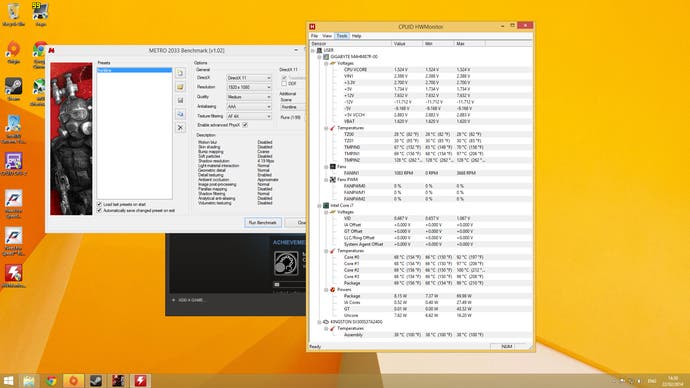
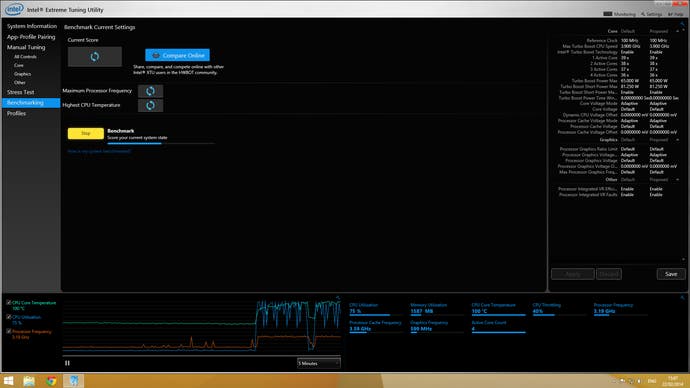
To test the theory, we downloaded Intel's Xtreme desktop monitor and benchmarking tool and confirmed our suspicions. Running the benchmark once, we noted that the CPU hit 3.6GHz max (the processor is rated for 3.9GHz if the thermal headroom is available) but the effects of the turbo were short-lived. Running the benchmark again, we started to see CPU throttling take effect - sometimes reaching 40 per cent. Restarting the Brix Pro and dipping into the BIOS, we turned off turbo boost and re-ran the tests. Unfortunately, there was no difference at all - indeed, we saw a one-off peak of 41 per cent CPU throttling. Attempts to push the fan to a sustained maximum speed proved fruitless - the BIOS appears to retain control over any software solution.
In short, it appears that while the Brix Pro incorporates a desktop chip, we aren't seeing it at its best. It hits thermal limits during gameplay and we suspect that this - and perhaps the eDRAM set-up - are at least partly responsible for the unit's curiously inconsistent performance.
Gigabyte Brix Pro - the Digital Foundry verdict
We came into this test looking at the Brix Pro as a marvel of technology - and one of the more exciting Steam Machines. This little box theoretically packs much more power into its tiny chassis than the monstrous i7 tower workstations we were using for our work here at Digital Foundry just a couple of years ago, and it's backed up by what is generally considered one of the most powerful integrated graphics solutions on the market. The Brix Pro should be the ultimate portable processing powerhouse - and a decent games machine to boot - making it a unique product and an intriguing, if pricey, Steam Machine.
"Typically, these systems host ultrabook low-voltage CPUs - unlike the Core i7-4770R seen here. The chip simply can't reach its full potential in this ultra-mini chassis."
Unfortunately, it's difficult to avoid the conclusion that Gigabyte has integrated a processor that's simply too powerful for the tiny chassis, leaving a remarkable piece of technology that's crying out for a better cooling solution. This may well have required a larger, taller box (with more, larger vents - the current design doesn't seem particularly well ventilated for the heat generated by a full desktop processor) but at least the CPU would have been able to reach its stated performance level - and sustain it. This doesn't rule out the Brix entirely. For general computing tasks, it takes a lot of effort to max an i7, so it may well be the unit will work just fine in many scenarios, but the fact that we reach thermal limits during gameplay is something of an issue for us.
Perhaps the biggest problem we have with the Gigabyte Brix Pro is that we simply can't anticipate performance on any given game. Tomb Raider ran well, suggesting great things, but Battlefield 4 didn't quite feel right, while Need for Speed: Rivals required significant compromises on resolution and quality settings simply to maintain 30fps. With Crysis 3, the situation initially looked impressive, but performance collapsed from one level to the next, meaning we had to cut down settings to an unacceptable level in order to maintain a playable frame-rate. Is it a thermal problem? A driver problem? An eDRAM utilisation problem? A combination, perhaps? It's really difficult to get a handle on just how capable the GPU is in this product.
In summary, what makes the Brix Pro unique - its ultra-small form factor and innovative integrated graphics solution - appear to be the same elements that hold it back from achieving gaming greatness. There'll be other Steam Machines of course - at least 11 of them this year - And we suspect that a good many of them will offer better performance at a lower price. And if they don't? It's an open platform and you could try building your own. That's what we're doing right now...
Many thanks to small form factor and gaming PC specialists Ambros for loaning us the Gigabyte Brix Pro for review.
